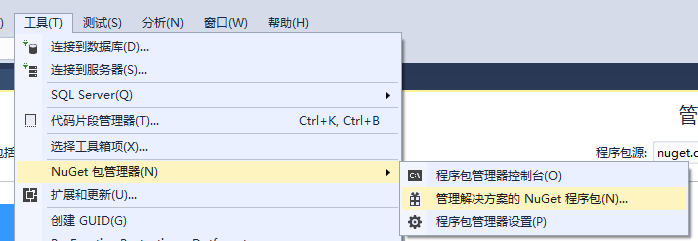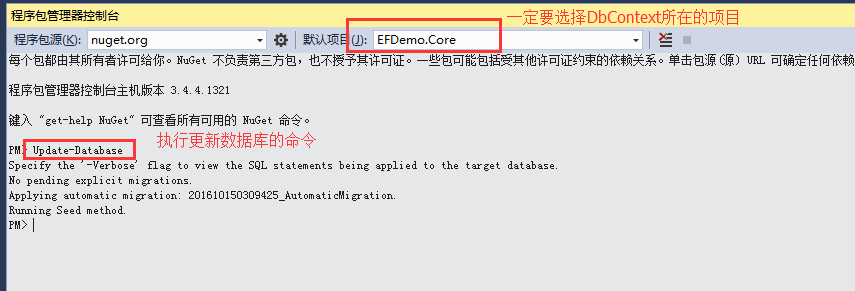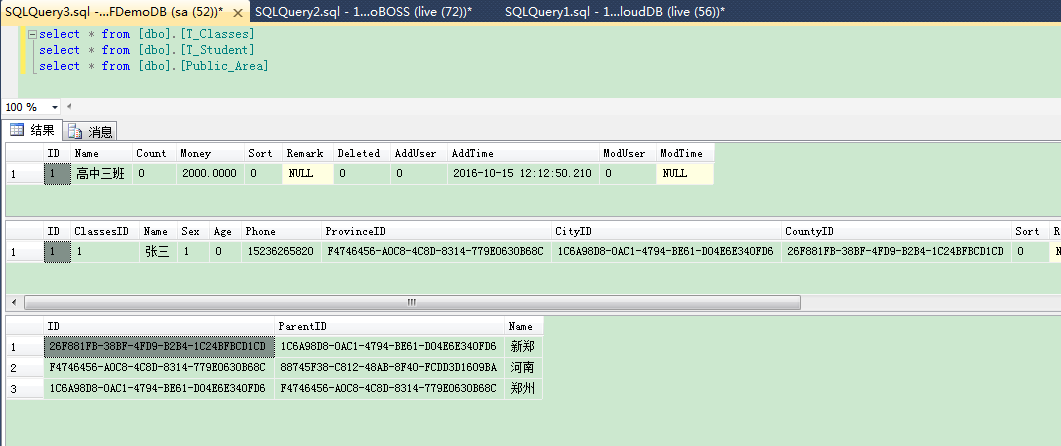前言
EF已經發布很久了,也有越來越多的人在使用EF。如果你已經能夠非常熟練的使用EF的功能,那么就不需要看了。本文意在將自己使用EF的方式記錄下來備忘,也是為了給剛剛入門的同學一些指導。看完此文,你應該就學會以CodeFirst的方式操作數據庫了。
本文主要內容
- CodeFirst生成數據庫的流程
- 初始化配置
- 數據庫實體構造技巧
- 主外鍵設置
- decimal精度修改
項目框架搭建
本文所使用的開發工具是vs2015(EF6.1.3)
第一步:新建一個空白項目

第二步:引用EntityFramework


?
DbContext的初始化配置
?DbContext作為操作數據庫的網關,十分重要。我們需要對它進行一些類的初始化操作,例如:解決團隊開發中,多人遷移數據庫造成的修改覆蓋問題。
代碼如下:
using System; using System.Collections.Generic; using System.Data.Entity; using System.Linq; using System.Text; using System.Threading.Tasks; using System.Data.Entity.ModelConfiguration.Conventions; namespace EFDemo.Core.EF {/// <summary>/// EF訪問數據庫的接口 /// </summary>public class MyDbContext : System.Data.Entity.DbContext{ public MyDbContext(): base("EFDemo"){//解決團隊開發中,多人遷移數據庫造成的修改覆蓋問題。Database.SetInitializer<MyDbContext>(null);//base.Configuration.AutoDetectChangesEnabled = false;////關閉EF6.x 默認自動生成null判斷語句//base.Configuration.UseDatabaseNullSemantics = true; } public MyDbContext(System.Data.Common.DbConnection oConnection): base(oConnection, true){this.Configuration.LazyLoadingEnabled = true; }protected override void OnModelCreating(DbModelBuilder modelBuilder){//表名不用復數形式modelBuilder.Conventions.Remove<PluralizingTableNameConvention>();//移除一對多的級聯刪除約定,想要級聯刪除可以在 EntityTypeConfiguration<TEntity>的實現類中進行控制modelBuilder.Conventions.Remove<OneToManyCascadeDeleteConvention>();//多對多啟用級聯刪除約定,不想級聯刪除可以在刪除前判斷關聯的數據進行攔截modelBuilder.Conventions.Remove<ManyToManyCascadeDeleteConvention>(); base.OnModelCreating(modelBuilder);}//將實體對象寫在這里,就可以生成對應的數據。 如下://public DbSet<Demo> Demo { get; set; } }}
項目位置:

Migrations下Configuration類的初始化配置
?Configuration類的初始化配置十分重要,我們需要通過配置解決一系列遷移問題。例如:允許自動遷移,自動遷移默認情況下不扔掉列在我們的數據庫中的表。如果我們不希望這樣的行為,我們可以告訴遷移明確允許數據丟失的配置類的AutomaticMigrationDataLossAllowed屬性設置為true。
代碼如下:
namespace EFDemo.Core.Migrations {using System;using System.Data.Entity;using System.Data.Entity.Migrations;using System.Linq;internal sealed class Configuration : DbMigrationsConfiguration<EFDemo.Core.EF.MyDbContext>{public Configuration(){//允許自動遷移//不然會報錯Unable to update database to match the current model because there are pending changes and automatic migration is disabled. Either write the pending model changes to a code-based migration or enable automatic migration. Set DbMigrationsConfiguration.AutomaticMigrationsEnabled to true to enable automatic migration.You can use the Add-Migration command to write the pending model changes to a code-based migration.//允許自動遷移AutomaticMigrationsEnabled = true;//自動遷移默認情況下不扔掉列在我們的數據庫中的表。如果我們不希望這樣的行為,我們可以告訴遷移明確允許數據丟失的配置類的AutomaticMigrationDataLossAllowed屬性設置為true。AutomaticMigrationDataLossAllowed = true;}protected override void Seed(EF.MyDbContext context){// This method will be called after migrating to the latest version.// You can use the DbSet<T>.AddOrUpdate() helper extension method // to avoid creating duplicate seed data. E.g.//// context.People.AddOrUpdate(// p => p.FullName,// new Person { FullName = "Andrew Peters" },// new Person { FullName = "Brice Lambson" },// new Person { FullName = "Rowan Miller" }// );// }} }
項目位置:

數據庫對應實體對象的定義
?CodeFirst模式需要我們先定義實體,然后通過實體生成數據。
通常我們設計數據庫表時,每個表都有(ID,是否刪除,備注,添加人,添加時間,修改人,修改時間)等字段。我們可以用基類處理
基類實體:


using System; using System.Collections.Generic; using System.ComponentModel; using System.ComponentModel.DataAnnotations; using System.ComponentModel.DataAnnotations.Schema; using System.Linq; using System.Text; using System.Threading.Tasks;namespace EFDemo.Core.Entity {public class BaseEntity{}[Serializable]public class BaseEntity<TKey> : BaseEntity{public BaseEntity(){this.AddTime = DateTime.Now;}[Key][Display(Name = "編號")]public TKey ID { get; set; }[Display(Name = "排序")][Required(ErrorMessage = "{0}是必填項"), Range(0, int.MaxValue, ErrorMessage = "{0}的范圍是{1}到{2}")][DefaultValue(0)]public int Sort { get; set; }[Display(Name = "備注")][MaxLength(256, ErrorMessage = "{0}最大長度{1}")]public string Remark { get; set; }[Display(Name = "是否刪除")][Required]public bool Deleted { get; set; }public int AddUser { get; set; }[Display(Name = "添加時間")][DisplayFormat(ApplyFormatInEditMode = true, ConvertEmptyStringToNull = true, DataFormatString = "{0:yyyy-MM-dd HH mm}", HtmlEncode = false, NullDisplayText = "數據無效")]public DateTime AddTime { get; set; }public int ModUser { get; set; }[DisplayFormat(ApplyFormatInEditMode = true, ConvertEmptyStringToNull = true, DataFormatString = "{0:yyyy-MM-dd HH mm}", HtmlEncode = false, NullDisplayText = "數據無效")]public DateTime? ModTime { get; set; }}}
省市區表:


using System; using System.Collections.Generic; using System.ComponentModel.DataAnnotations; using System.ComponentModel.DataAnnotations.Schema; using System.Linq; using System.Text; using System.Threading.Tasks;namespace EFDemo.Core.Entity {/// <summary>/// 省市區/// </summary>public class Public_Area{ [Key]public Guid ID { get; set; }[Display(Name = "父親ID")]public Guid ParentID { get; set; }[Display(Name = "名稱")][MaxLength(32, ErrorMessage = "{0}最大長度{1}")]public String Name { get; set; }} }
班級表:


using System; using System.Collections.Generic; using System.ComponentModel.DataAnnotations; using System.ComponentModel.DataAnnotations.Schema; using System.Linq; using System.Text; using System.Threading.Tasks;namespace EFDemo.Core.Entity {/// <summary>/// 班級/// </summary>public class T_Classes : BaseEntity<int>{public T_Classes() {this.T_Student = new List<Entity.T_Student>();}[InverseProperty("T_Classes")]public virtual List<T_Student> T_Student { get; set; }[Display(Name = "班級名稱")][Required(ErrorMessage = "{0}是必填項")][MaxLength(8, ErrorMessage = "{0}最大長度{1}")]public string Name { get; set; }[Display(Name = "人數")]public int Count { get; set; }[Display(Name = "班級經費")]public decimal Money { get; set; }} }
?
學生表:


using System; using System.Collections.Generic; using System.ComponentModel.DataAnnotations; using System.ComponentModel.DataAnnotations.Schema; using System.Linq; using System.Text; using System.Threading.Tasks;namespace EFDemo.Core.Entity {/// <summary>/// 學生/// </summary>public class T_Student : BaseEntity<int>{/// <summary>/// 外鍵/// </summary>[ForeignKey("ClassesID")]public virtual T_Classes T_Classes { get; set; }[Display(Name = "班級ID")]public int ClassesID { get; set; }[Display(Name = "姓名")][Required(ErrorMessage = "{0}是必填項")][MaxLength(8, ErrorMessage = "{0}最大長度{1}")]public string Name { get; set; }[Display(Name = "性別")]public bool Sex { get; set; }[Display(Name = "年齡")]public int Age { get; set; }[Display(Name = "電話")][Required(ErrorMessage = "{0}是必填項")][RegularExpression(@"^(13[0-9]|15[0-9]|18[0-9])\d{8}$", ErrorMessage = "不是手機號格式")][MaxLength(11, ErrorMessage = "{0}最大長度{1}")]public string Phone { get; set; }/// <summary>/// 省市縣外鍵/// </summary> [ForeignKey("ProvinceID")]public virtual Public_Area Public_Area_Province { get; set; }[Display(Name = "省ID")]public Guid ProvinceID { get; set; }[ForeignKey("CityID")]public virtual Public_Area Public_Area_City { get; set; }[Display(Name = "市ID")]public Guid CityID { get; set; }[ForeignKey("CountyID")]public virtual Public_Area Public_Area_County { get; set; }[Display(Name = "縣ID")]public Guid CountyID { get; set; }} }
?
班級表和學生表是一對多的關系,省市區表和學生表是一對多的關系,同時學生表中有多個省市區表的外鍵。
項目位置:

?
使用命令生成數據庫
第一步:將實體對象加入到DbContext中,
如下:
//將實體對象寫在這里,就可以生成對應的數據。 如下://public DbSet<Demo> Demo { get; set; }public DbSet<Public_Area> Public_Area { get; set; }public DbSet<T_Classes> T_Classes { get; set; }public DbSet<T_Student> T_Student { get; set; }
第二步:在EFDemo.Core項目下的App.config文件夾中添加生成數據庫的配置項
?

?
配置文件代碼如下:
name="EFDemo"中的EFDemo要和DbContex中的一致。? <?xml version="1.0" encoding="utf-8"?> <configuration><configSections><!-- For more information on Entity Framework configuration, visit http://go.microsoft.com/fwlink/?LinkID=237468 --><section name="entityFramework" type="System.Data.Entity.Internal.ConfigFile.EntityFrameworkSection, EntityFramework, Version=6.0.0.0, Culture=neutral, PublicKeyToken=b77a5c561934e089" requirePermission="false" /></configSections><connectionStrings><!--生成數據庫的連接字符串--><add name="EFDemo" connectionString="Data Source=.;Initial Catalog=EFDemoDB;User ID=sa;Password=123456;MultipleActiveResultSets=True;Application Name=EntityFramework" providerName="System.Data.SqlClient" /></connectionStrings><entityFramework><defaultConnectionFactory type="System.Data.Entity.Infrastructure.LocalDbConnectionFactory, EntityFramework"><parameters><parameter value="mssqllocaldb" /></parameters></defaultConnectionFactory><providers><provider invariantName="System.Data.SqlClient" type="System.Data.Entity.SqlServer.SqlProviderServices, EntityFramework.SqlServer" /></providers></entityFramework> </configuration>
?
第三步:執行更新命令
啟動項目一定要選擇EFDemo.Core

生成數據庫如下:


主外鍵關系設置
?班級和學生一對多關系的設置:

一個表中的多個外鍵是另一個表中的主鍵的情況:學生表和省市縣表

生成的數據庫如下:

需要注意的是:這種情況,在Public_Area表中不能反向設置?public virtual List<T_Student> T_Student ,不然會報錯。
?
decimal怎么保存四位小數
?decimal默認保留兩位小數,我們需要通過如下設置讓其保留四位小數。
在DbContext中配置班級表中的Money字段讓其保留四位小數:

?執行Update-Database命令:
結果如下:

?
?
??
使用EF操作數據庫數據
第一步:
?讓EFDemo.Web應用EFDemo.Core程序集。
第二步:
配置EFDemo.Web中的webconfig中的數據庫連接字符串:
<connectionStrings><!--操作數據庫的連接字符串--><add name="EFDemo" connectionString="Data Source=.;Initial Catalog=EFDemoDB;User ID=sa;Password=123456;MultipleActiveResultSets=True;Application Name=EntityFramework" providerName="System.Data.SqlClient" /></connectionStrings>
第三步:
使用EF向數據庫添加數據
public ActionResult Index(){using (var db = new Core.EF.MyDbContext()){Public_Area area1 = new Public_Area(){ID = Guid.NewGuid(),Name = "河南",ParentID = Guid.NewGuid()};db.Public_Area.Add(area1);Public_Area area2 = new Public_Area(){ID = Guid.NewGuid(),Name = "鄭州",ParentID = area1.ID};db.Public_Area.Add(area2);Public_Area area3 = new Public_Area(){ID = Guid.NewGuid(),Name = "新鄭",ParentID = area2.ID};db.Public_Area.Add(area3);//添加測試數據T_Classes classes = new T_Classes(){Name = "高中三班",Money = 2000};db.T_Classes.Add(classes);T_Student student = new T_Student(){ClassesID = classes.ID,Name = "張三",Phone = "15236265820",Sex = true,ProvinceID = area1.ID,CityID = area2.ID,CountyID = area3.ID,};db.T_Student.Add(student);db.SaveChanges();}return View();}
第四步:
查看數據庫數據

?
Demo完整代碼下載
EFDemo.Core.7z
?
下一篇:EF查詢之性能優化技巧
?
方法和示例)


函數從數組中刪除元素)

)

方法(帶示例))



方法)



方法(帶示例))

方法與示例)

